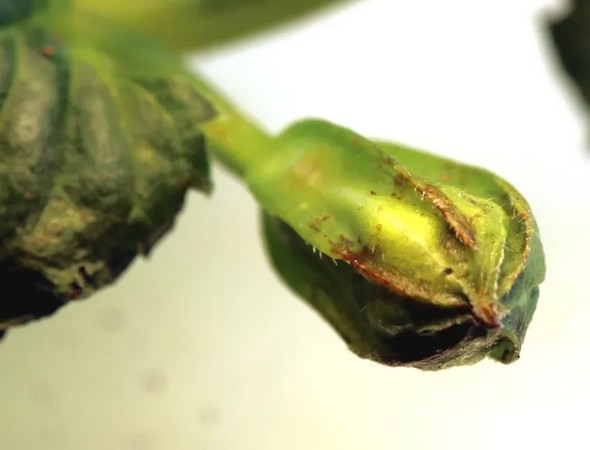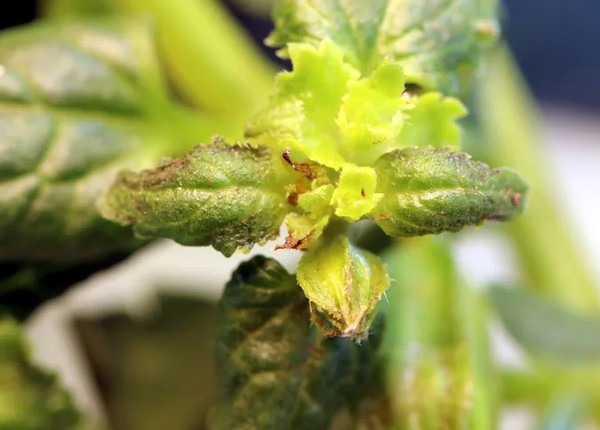In spring crops, especially Reiger begonias and New Guinea impatiens, Broad Mites can create quite some damage. . Other crops that are commonly affected include torenia, exacum, ipomea and gerbera.
Broad mite are often difficult to detect and control. Read on for tips on monitoring and the latest management strategies for this pest.
Monitoring
Unfortunately, broad mite’s small size (0.2 mm) means that spotting the mite is near impossible using just a hand lens. Damage is usually the first sign a grower sees, so susceptible crops should be walked and inspected regularly. Damage can occur at very low mite densities, and often doesn’t occur for a good 20 to 30 days after the crop has already been infested.

Broad mite, Polyphagotarsonemus latus. Photo credit: USDA BARC
Here’s what typical damage can look like:
Broad mites feed on new growth, so that’s where you want to look. The mite’s toxic saliva results in copper or purplish-colored damage on growing points. Leaves often turn downwards. Unfortunately, “new growth” also means buds, which can become discolored and malformed. Flowers often are prevented from fully developing. Petioles and internodes can also become shortened, so look for stunted plant growth, as well.
Is it broad mite? Or something else?
if damage from broad mite is suspected, it’s important to confirm the diagnosis by actually seeing the mites using a microscope (or having them confirmed by OMAFRA staff or an experienced scout).
Broad mite damage can easily be confused with things like:
- Herbicide injury
- Nutritional (boron) deficiencies
- Physiological disorders. For example, under cooler temperatures and high humidity, leaf curling can be seen on New Guinea impatiens
You may not see the adult mites themselves, but spotting even 1 egg (see picture below), along with characteristic damage, is usually enough to confirm that broad mite is the culprit.

Broad mite damage on torenia. Photo by S. Jandricic, OMAFRA.
However, if you grow a lot of susceptible crops (refer to this list of “magnet” crops), or you’ve regularly had broad mite issues in the past, you may want to consider a more rigorous monitoring regime specific to this pest. This involves taking random samples of meristems, washing them in alcohol, and inspecting the contents under a microscope on a regular basis. Details of this technique can be found here.
I’ve confirmed broad mite: now what?
Biological control can be an option, if it is well timed. Neoseiulus cucumeris, N. californicus and A. swirskii can all suppress this pest. Beneficial mites should be introduced early in the crop cycle of susceptible crops to prevent broad mites from establishing, and high rates of release will be needed over the life of the crop. If the crop in question can tolerate it, biocontrol of broad mite is found by some consultants to be more effective if the pest is first suppressed with an application of Suffoil X or another type of mineral oil. (Reminder: always do phytotoxicity testing first before hitting young plants with oil).

Broad mite damage on unopened buds. Photo by S. Jandricic, OMAFRA
For more details on biocontrol of broad mites, take a look at these articles from Michigan State Extension and Dr. Rose Buitenhuis (Vineland Research)
Miticides are often your best option, especially in crops that are generally only susceptible to mite pests, where a “one and done” spray approach can be taken when the crops are young. However, it can often unclear which miticides are effective against mite pests besides spider mites. For broad mite, here are the effective products:
- Avid (abamectin; Group 6): has translaminar activity, making it a good choice since it builds up a reservoir of active ingredient in the leaf.
- Forbid (spiromesifen; Group 23) is active against both eggs and adults of broad mite. It has translaminar activity. However, Forbid has demonstrated phytotoxicity on impatiens and geraniums, and should be avoided on these crops.
- FujiMite (fenpyroximate; Group 21) can also be effective, but it only has contact activity, so it is best for young plants (before bud formation) or as a preventative application. It can also be relatively slow acting.
- Pylon (chlorfenapyr; Group 13) has contact and translaminar activity, similar to Avid. It affects both adult and immature mites. Pylon also carries a risk of phytotoxicity to certain plants, so check the label before use.
Note: many growers have been finding Avid hasn’t been working as well as it used to, and are turning to a combination of Avid/Pylon or another chemistry. Also, remember that all of the chemistries listed are also hard on predatory mites, so they should only be used on plant species where broad mite (and not thrips!) are your main and only pest of concern.
For more information: OMAFRA
OMAFRA
www.omafra.gov.on.ca
